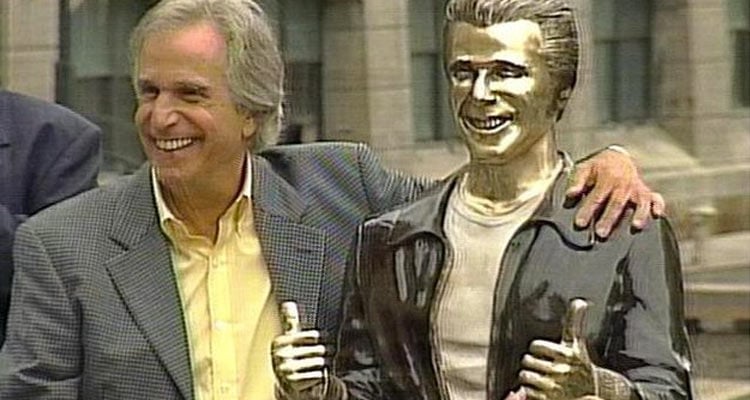Take yourself back to August 19, 2008: The Obama/McCain race for the White House was in full swing, The Sisterhood Of The Traveling Pants 2 was packing multiplexes, and the New Kids On The Block were dominating the airwaves with the stunning comeback single “Summertime.” Meanwhile, in downtown Milwaukee, a highly contentious bronze statue of TV’s Arthur Herbert Fonzarelli was being unveiled, capping off a yearlong controversy that pitted Milwaukeean vs. Milwaukeean in a battle for the city’s very soul.
A brief refresher: In late 2007, local tourism organization VISIT Milwaukee announced plans to erect a bronze statue of the iconic character in the downtown area. (Because, you know, Happy Days was supposed to have taken place in Milwaukee.) The idea was originally part of a nationwide campaign, sponsored in part by TV Land, to place statues of old television characters in various U.S. cities. But when TV Land discontinued the program, Milwaukee decided to go ahead with the Bronze Fonz on its own. Nothing would stop Milwaukee from getting its Fonzie.
And then the shit hit the fan. David Fantle, vice president of public relations for VISIT Milwaukee, was one of the champions of the project; Mike Brenner, a local artist and proprietor of Riverwest’s Hotcakes Gallery, was vehemently opposed to it. At the heart of the controversy was the question of Milwaukee’s image. (The statue’s location was also an issue. Originally planned for the intersection of Wisconsin and Water, is was eventually moved to the RiverWalk.) “For a couple years, all of us running venues started to notice a shift—visitors starting to ask about Milwaukee’s underground music and arts scene,” Brenner remembered in 2011. “Then in two months, $85,000 was raised for the Bronze Fonz and our efforts were pushed back 10 years. It was a big slap in the face.”
One of the most fascinating aspects of the Bronze Fonz drama was the culture war it ignited. Local media quickly divided folks into two opposing, cartoonish camps: the uptight, faux-intellectual artsy types who considered the project tacky and insulting; and the mouth-breathing boobs who sympathized with the clueless civic boosters behind it. When Brenner publicly threatened to close his gallery if the statue were actually built, things got even more heated. Harsh words were exchanged—often homophobic—and death threats were made. (Brenner later collected a series of threatening voicemails and set them to music.) When the bizarre, TV Land-fueled firestorm reached its peak, Brenner made good on his promise, and closed the doors to Hotcakes on July 3, 2008.
A little more than a month later, on August 19, the Bronze Fonz, created by artist Gerald P. Sawyer, was officially dedicated; former cast members of Happy Days—including a clearly bemused Henry Winkler—even showed up to press the flesh. In the months that followed, VISIT Milwaukee won a 2009 Destiny Award from the National Council Of Destination Organizations, and a gold medal from the Society Of American Travel Writers for “best publicity campaign for a convention and visitors bureau.” Pictures of Milwaukee natives and tourists alike posing with the grinning bronze visage became commonplace, and when it wasn’t being kissed, fondled, or mounted, the statue was known to catch the attentions of travel writers far and wide.
The key players in the drama eventually moved on. David Fantle would soon leave VISIT Milwaukee and accept a position as deputy secretary for the Wisconsin Department of Tourism. Brenner redirected his energies toward beer, and eventually opened Brenner Brewing Co. “Now that the death threats have stopped, I don’t think about the Bronze Fonz anymore,” he said in 2011. “But if somebody tossed that thing into the river, they would definitely get a lifetime supply of beer from the Brenner Brewing Co.” (Brenner Brewing Co. closed in 2017.)
Like Brenner, Milwaukee seems to have left the controversy behind. Far from the hotly contested piece of public art that once threatened to make or break a city, the statue is now a kitschy, harmless landmark—an $85,000, non-moving, non-ride-able version of La Perla’s old mechanical pepper. And if revisiting the uproar after so many years makes little sense, it’s only because nothing in the ridiculous Bronze Fonz saga ever did.

